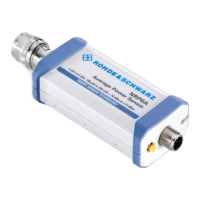R&S NRP System settings (System menu)
1144.1400.12 4.59 E-2
Analog Out
Trigger In –
( )
ä
Selects the function of port I/O 2.
In the case of
Analog Out, a voltage is output to I/O 2 that is proportional
to the value currently displayed in the selected window (
Window 1...).
In the case of
Trigger In, I/O 2 serves as an external trigger input.
Remote Control, Analog
OUTPut:TTL[1]:STATe[?] ON
Trigger In
OUTPut:TTL[1]:STATe[?] OFF
Background information
The voltage at the analog outputs does not follow the power fed to the sensor continuously but rather at
discrete points of time. Every time the sensor has transmitted a new measured value to the base unit,
i.e. after a time window has been evaluated ( Filter / averaging, page 4.19), the voltage is adjusted to
the new value.
In the ContAv mode, you can influence the rate at which the voltage is updated with the aid of the sam-
pling window ( Free-running average-power measurements, page 4.8). The time between two up-
dates of the output voltage is approximately twice the length of the sampling window. The lower limit of
this length of time, during which the R&S NRP can still regularly update the output voltage, depends on
the number of sensors connected and their measurement mode. With a connected sensor in the Con-
tAv mode, it is about 1 ms.
Switching on the averaging filter does not affect the refresh rate, but the speed at which the output volt-
age changes can be expected to slow down as a result of the filter effect.
For applications having high requirements on the dynamic behaviour of the analog outputs, for example
phase-locked loops, it is advisable to freeze the screen of the R&S NRP to avoid discontinuities caused
by writing to the screen memory ( Miscellaneous
Operation at low ambient temperatures, page 4.64).

